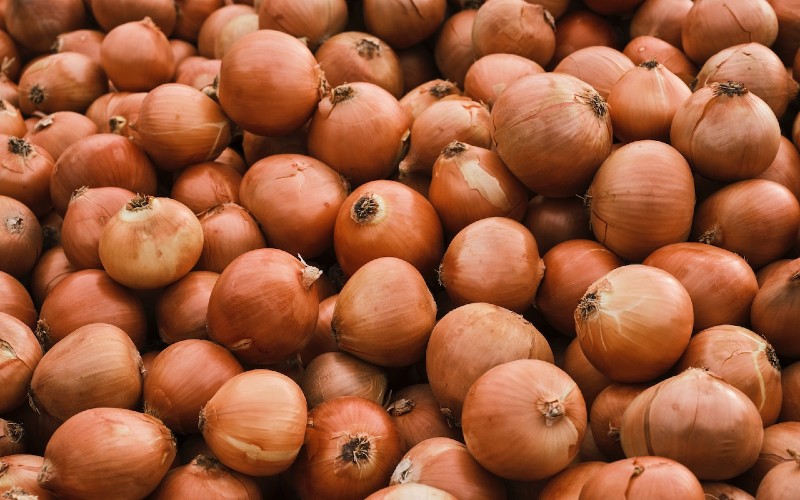Sweet Onion Substitutes – Perfect Alternatives for Your Culinary Adventures!
Sweet onions have long been an iconic staple in culinary traditions worldwide. Revered for their unique blend of sweetness and mildness, they are the subtle secret that can take a dish from good to great. But what happens when you don’t have this culinary gem at hand? Is it possible to find alternatives that match, or even enhance, the distinct flavor profile of sweet onions?
The answer is a resounding yes. Whether it’s due to a unique dietary restriction, the seasonal unavailability of sweet onions, or a desire to experiment with diverse flavors, there is a myriad of substitutes that you can use. This comprehensive guide explores these alternatives, delving into the world of flavorful possibilities that lie beyond sweet onions.
Unraveling The Sweet Onion
Sweet onions, known for their higher sugar content and lower sulfur, differ from their other onion counterparts by offering a sweet flavor that is mild and not overpowering. Their larger size and juiciness make them a beloved ingredient in a plethora of dishes – from adding a crunch to salads, to being caramelized for a savory tart, or simply being eaten raw.
Furthermore, sweet onions are a treasure trove of nutritional benefits. Packed with Vitamin C, fiber, and antioxidants, they’re as good for your health as they are for your taste buds. A few popular varieties of sweet onions exist, such as Vidalia, Walla Walla, and Maui. Each variety offers a slightly different flavor profile and level of sweetness, adding to the versatility of this remarkable bulb.
Factors to Consider When Selecting a Sweet Onion Substitute
Selecting a substitute for sweet onions isn’t as straightforward as it might initially seem. Several factors play into this decision. The flavor profile, which is the unique balance of sweetness and mildness that defines sweet onions, is an essential consideration. While no onion variety or substitute matches this exactly, there are many alternatives that come remarkably close.
The texture is another key factor. Sweet onions are known for their crisp, juicy texture that adds a layer of complexity to dishes. Therefore, any potential substitute should ideally come close to this texture.
The nutritional content of the substitute is also important, especially if the substitution is being made due to dietary restrictions or health considerations. Lastly, the availability and cost of the substitute can also influence the choice.
List of Sweet Onion Alternatives
Standard Onions
Standard onions, including yellow, white, and red varieties, are the most common replacements for sweet onions. Although they’re generally stronger in flavor, cooking methods like sautéing or caramelizing can mellow their pungency and draw out their natural sweetness. Yellow onions, which are full-bodied and strong, are great for dishes requiring a prominent onion flavor. White onions, milder and crispier, are ideal for Mexican dishes, while red onions, with their distinct color and slightly sweet taste, shine in salads, salsas, and other fresh preparations.
Shallots
Shallots are often described as a cross between onions and garlic in terms of flavor, offering a balanced mix of sweet and sharp. Their flavor is more refined compared to standard onions, and they can offer a subtle, gourmet touch to dishes. Shallots can be caramelized to enhance their sweetness or minced and used raw in vinaigrettes, sauces, and garnishes.
Leeks
The leek, a relative of the onion, offers a gentler flavor that makes it a fitting substitute for sweet onions. The white and light green parts are used in cooking and can be sweated, sautéed, or added to soups and stews. Their sweet, mild flavor and tender texture after cooking make them a great replacement in dishes where a more delicate onion flavor is desired.
Scallions or Green Onions
Scallions, also known as green onions, are milder than many onion types, providing a sweet and tender flavor profile when cooked. Both the green and white parts can be used, offering different levels of intensity. Scallions can be chopped and used in salads, stir-fries, and Asian-inspired dishes where a light, fresh onion taste is called for.
Chives
Chives are milder than onions and are typically used fresh to maintain their delicate flavor. Their grassy taste with a hint of garlic is excellent in salads, soups, and as garnish. When sweet onions are needed raw for a pop of sweetness, chives can be an ideal replacement if mildness is the priority.
Pearl Onions
Pearl onions are small, marble-sized onions that are sweeter than common onions. Their size makes them ideal for pickling, roasting whole, or adding to stews and casseroles. They come in yellow, red, and white varieties, all offering a unique balance of sweetness and onion flavor.
Vidalia Onions
If you can’t find a specific sweet onion variety, Vidalia onions, celebrated for their sweetness, can step in. They’re known for their mild, sweet flavor and can be used interchangeably with other sweet onions in recipes.
Cipollini Onions
Cipollini onions, flat and disc-shaped, are known for their sweet, intense flavor when cooked. They’re excellent for roasting, braising, or caramelizing, and make a distinctive substitute for sweet onions in dishes that call for a robust onion presence.
Maui Onions
Hailing from the picturesque slopes of Mt. Haleakala in Hawaii, Maui onions share a low sulfur content and high sugar levels with Vidalia onions. This makes them a natural substitute for their more famous counterpart. While Maui onions might be abundant in their native region, they can be more challenging to find in the mainland US. However, their sweet and juicy nature makes them a perfect fit for raw dishes like salads and salsas or caramelized to bring out their natural sweetness.
Texas Sweet Onions
Grown in the fertile soil of the Rio Grande Valley in Texas, these onions offer a sweet and tender texture due to the presence of eugenol. Texas sweet onions are in season from March until June, providing a window of opportunity to enjoy their mild and pleasant flavor. They work beautifully in any recipe that calls for sweet onions, from grilling to sautéing, adding a delightful touch to salads, savory baked goods, and various cooked dishes.
Potato Onions
Resembling small potatoes and capable of propagating by themselves, potato onions offer a flavor profile that falls between red and Vidalia onions. Though they might not be as sweet as Vidalia onions, they are still milder than red onions, making them a suitable option for salads, sandwiches, and caramelizing in low heat for casseroles and stews.
Onion Powder or Onion Granules
When fresh onions aren’t available, onion powder or granules can step in. They offer the convenience of long shelf life and a ready-to-use format. Use them sparingly in sauces, rubs, marinades, or any dish requiring a quick onion flavor without the texture.
Non-Onion Sweet Onion Substitutes
Fennel Bulbs
Fennel bulbs offer a mildly sweet, anise-like flavor and a crunchy texture that makes them an excellent sweet onion substitute. They can be used raw in salads or cooked in stews, soups, or roasts, providing a subtly different flavor profile.
Celery
Celery brings a different flavor profile to the table. Its crunchy texture can mimic onions in salads or slaws, while cooked celery, with its mild sweetness, can substitute for caramelized sweet onions.
Jicama
Jicama, a root vegetable, is sweet, starchy, and crisp, making it a suitable raw substitute for sweet onions in salads, salsas, or slaws.
Bell Peppers
Bell peppers can substitute sweet onions in dishes where the onion primarily provides texture and color. Their sweet flavor and crunch are perfect for stir-fries, fajitas, or salads.
Apple
An unexpected but fascinating substitute for sweet onions is the humble apple. Offering a sweet and slightly tart flavor profile, apples can be an intriguing alternative in both raw and cooked dishes. In salads, finely sliced or diced apples provide a juicy crunch. When cooked, apples can soften and mellow, much like onions do, while adding a unique sweetness that can elevate a dish.
How to Use Sweet Onion Substitutes
Knowing how to use sweet onion substitutes effectively can elevate your culinary creations and make them indistinguishable from recipes featuring sweet onions.
Now that we have explored the best sweet onion substitutes, let’s discover how to use them effectively in various dishes. Each substitute offers its own unique characteristics, which can be harnessed to enhance specific recipes and bring out delightful flavors.
Raw Dishes
For dishes that require the sweet, mild taste of Vidalia onions in their raw state, substitutes like Walla Walla onions, Maui onions, and scallions work exceptionally well. These substitutes provide a similar level of sweetness and can be used in salads, salsas, platters. They add a refreshing and crisp element to your dishes, complementing other ingredients.
Caramelized Dishes
When it comes to caramelizing onions, Texas sweet onions, white onions, and potato onions are perfect choices. Their natural sweetness intensifies during caramelization, making them ideal for dishes like onion rings, French onion soup, and onion jam. Caramelization unlocks a rich and sweet flavor, elevating your dishes to new heights.
Cooked Dishes
For recipes that involve cooking onions along with other ingredients, yellow onions, red onions, and shallots make excellent substitutes. Their flavors blend well with other components, enhancing the overall taste of the dish. Use these substitutes in dishes like stir-fries, curries, stews, and roasted vegetables. They add a robust and savory dimension to your creations.
Specialty Dishes
Leeks and cipollini onions can add a unique twist to specialty dishes. Leeks work exceptionally well in quiches, omelets, and creamy soups, while cipollini onions add a gourmet touch to roasted meat and vegetable dishes. These specialty substitutes provide a touch of culinary elegance and intrigue to your special recipes.
Tips For Using The Substitutes In Your Dishes
- Adjust the quantity: Since sweet onion substitutes can vary in flavor intensity, adjust the quantity accordingly to suit your taste preferences.
- Raw vs. cooked dishes: Consider the flavor and texture of the substitute when using it in raw or cooked dishes. Some substitutes may be better suited for raw consumption, while others shine when cooked.
- Caramelization: Experiment with caramelizing your chosen substitute to achieve a sweeter flavor profile, especially if your recipe calls for caramelized sweet onions.
- Timing: Add the substitute at the appropriate stage of cooking to ensure it complements other ingredients and does not overpower the dish.
- Garnishing: Some substitutes, like scallions and chives, work best as garnishes due to their delicate flavor. Sprinkle them on top of your finished dish to add a burst of fresh onion taste.
How to Choose the Right Substitute
Choosing the right substitute depends largely on the dish. Consider the flavor profile – does it need the sweetness or the texture of onions? Is the onion a background note or the star of the show? Also, the cooking method and time matter, as onions and their substitutes behave differently under heat.
FAQs
Can I directly substitute Vidalia onions with any sweet onion substitute in my recipes?
In most cases, yes, you can directly substitute Vidalia onions with any of the sweet onion substitutes mentioned in this guide. However, keep in mind that each substitute has its unique flavor profile and characteristics. While they all provide sweetness, some substitutes may have a slightly different taste and texture. It’s a good idea to experiment and adjust the quantities to suit your personal preferences and the specific dish you’re preparing.
Can I use sweet onion substitutes in raw dishes, such as salads or salsas?
Absolutely! Many sweet onion substitutes, such as Walla Walla onions, Maui onions, and scallions, are perfect for raw dishes. They offer a mild and sweet flavor that complements salads, salsas, and other raw preparations. Feel free to use these substitutes to add a refreshing and delicious touch to your favorite raw recipes.
Can I caramelize sweet onion substitutes like Texas sweet onions and white onions?
Yes, you can caramelize sweet onion substitutes just like you would with Vidalia onions. Caramelization enhances their natural sweetness and brings out rich flavors, making them ideal for dishes like onion rings, French onion soup, and onion jam. Adjust the cooking time and heat to achieve the desired level of caramelization, ensuring that the substitutes become tender and sweet without burning.
Are there any substitutes for Vidalia onions that are less sweet?
If you prefer a less sweet substitute, options like white onions, red onions, and shallots are suitable choices. While they are still sweeter than regular cooking onions, their flavor is more pronounced and less sweet compared to Vidalia onions. Use these substitutes in dishes that require a stronger onion flavor without overwhelming sweetness.
Can I use sweet onion substitutes in all types of cuisines?
Yes, sweet onion substitutes are versatile and can be used in various cuisines. Whether you’re preparing Western, Asian, Mediterranean, or any other type of cuisine, these substitutes can seamlessly replace Vidalia onions to add sweetness and flavor to your dishes. Be adventurous and experiment with different substitutes to create unique and delicious dishes from around the world.
Where can I find specialty sweet onion substitutes like cipollini onions?
Specialty sweet onion substitutes like cipollini onions may be found in specialty grocery stores, farmer’s markets, or gourmet food stores. While they may not be as readily available as regular sweet onions, they offer a distinct taste and appearance that can elevate your dishes to a gourmet level. Keep an eye out for seasonal availability and local produce to find these unique substitutes.



